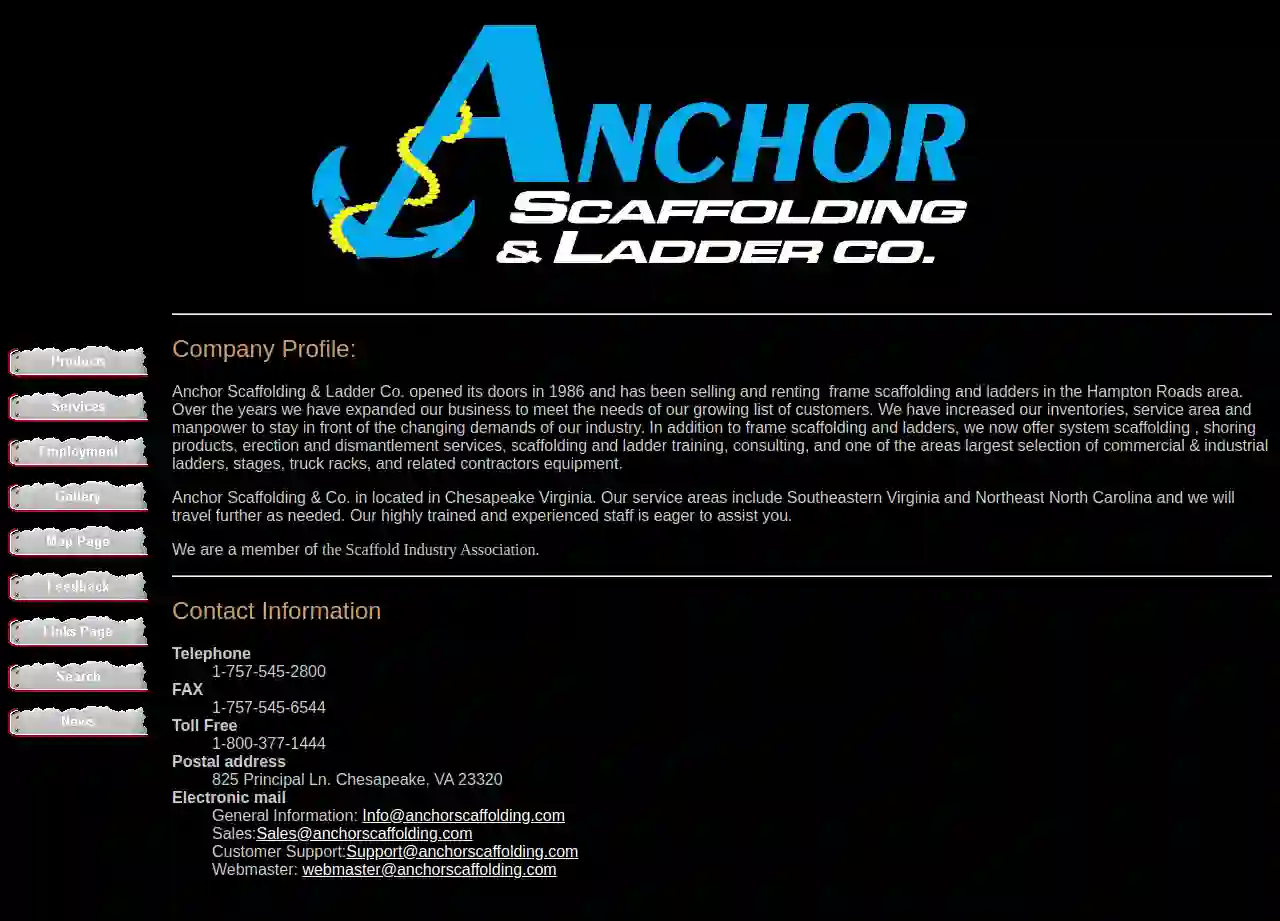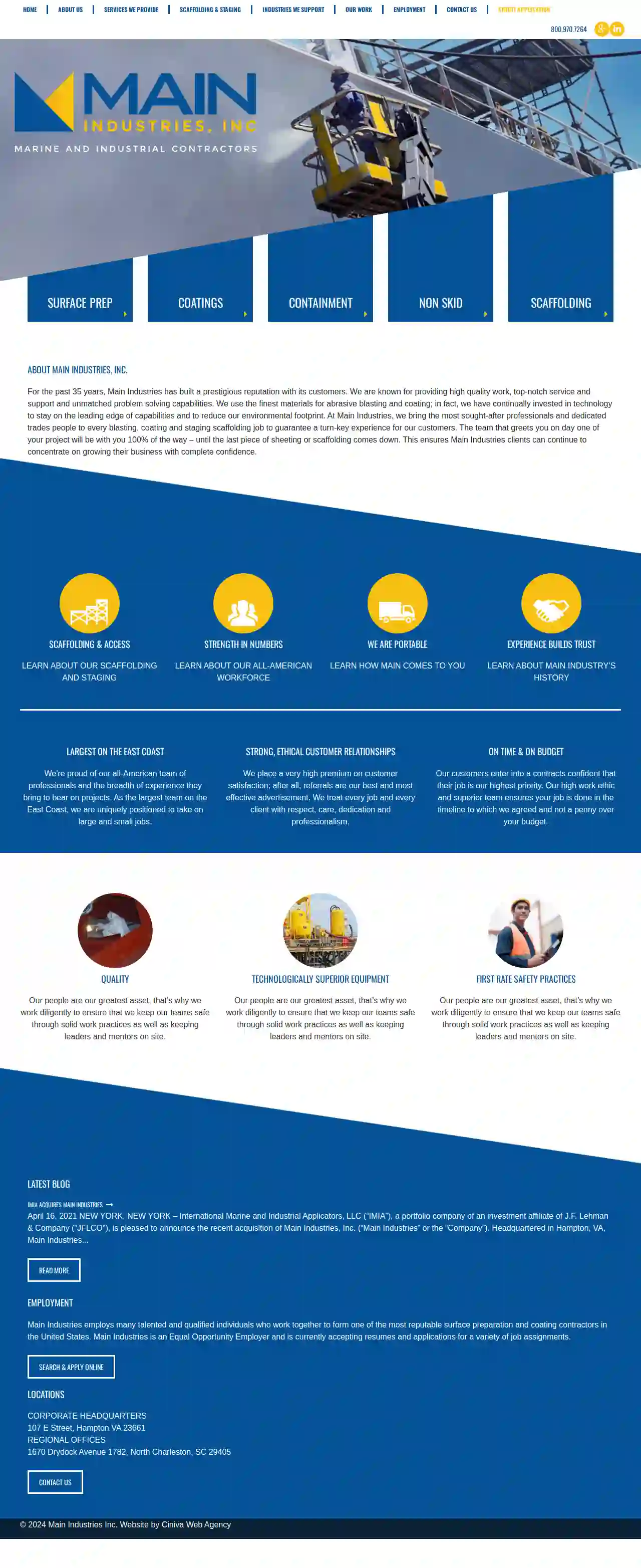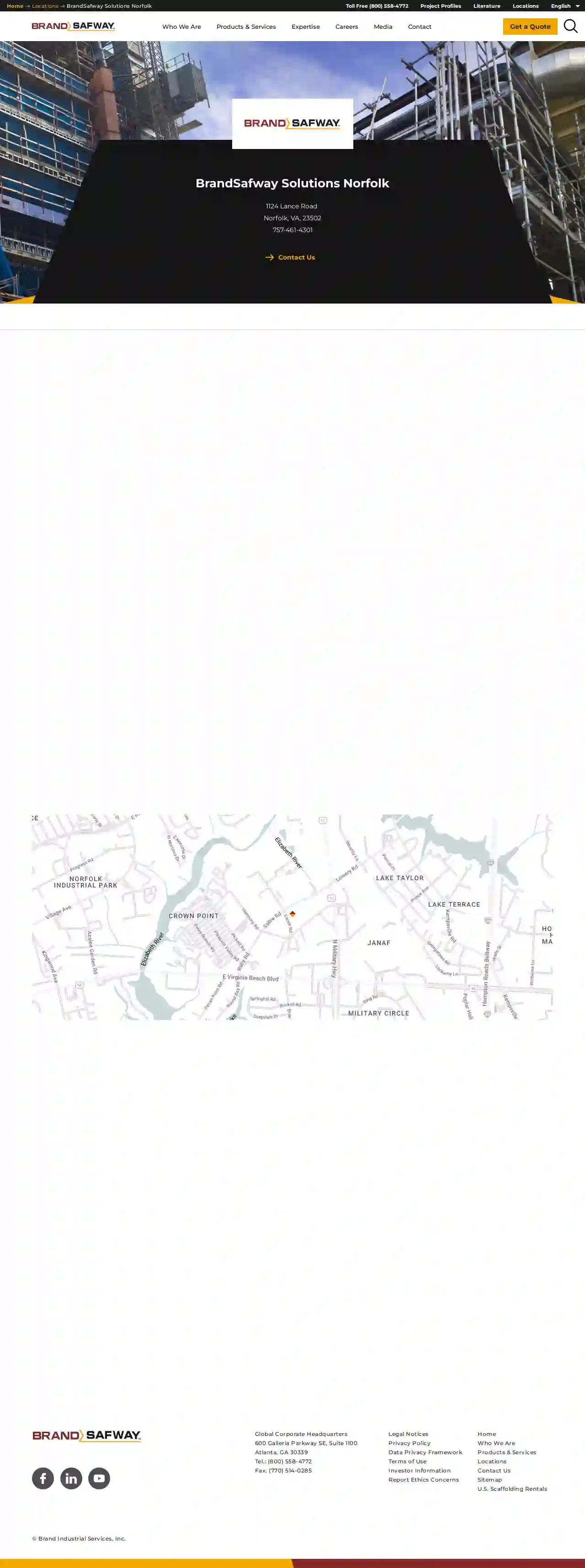Scaffolding Rental Hollymead
Find top Scaffolding Hire in Hollymead
Get multiple Scaffolding Hire quotes for your project today! Compare profiles, reviews, accreditations, portfolio, etc... and choose the best offer.

Anchor Scaffolding & Ladder Co
4.510 reviews825 Principal Ln., Chesapeake, 23320, USAnchor Scaffolding & Ladder Co. is a premier source for scaffolding and ladders in the Hampton Roads area. Founded in 1986, we have been selling and renting frame scaffolding and ladders, as well as offering system scaffolding, shoring products, erection and dismantlement services, scaffolding and ladder training, consulting, and a wide selection of commercial & industrial ladders, stages, truck racks, and related contractors equipment. Our highly trained and experienced staff is eager to assist you. We are a member of the Scaffold Industry Association and located in Chesapeake, Virginia, serving Southeastern Virginia and Northeast North Carolina.
- Services
- Why Us?
- Gallery
Get Quote
Main Industries Inc
4.534 reviews107 E Street, Hampton, 23661, USMain Industries, Inc. is a 38-year-old, employee-owned company that has earned an excellent reputation for providing surface preparation and coating services to the U.S. Navy, U.S. and foreign flag commercial vessels, and industrial customers. We are an employee-owned company under our company-wide Employee Stock Ownership Plan (ESOP), which contributes to our employee retention, commitment, and performance. Main Industries has built a prestigious reputation with its customers for providing the finest available service for abrasive blasting, coating application, and scaffolding and access needs.
- Services
- Why Us?
- Accreditations
- Gallery
Get Quote
American Scaffold
4.58 reviewsPO Box 2364, Daphne, 36526, USYour Expert Solution for Challenging Workplace Access and Environmental Containment Needs Unmatched Onsite Leadership and Specialist Expertise for Industrial and Shipyard Projects Request a Quote We're hiring Join the American Scaffold Team Today. Seeking dedicated laborers and scaffolders; apply now and grow with us. Learn More Premier Scaffold Solutions for Industrial and Shipyard Excellence Comprehensive Expertise and Solutions for Workplace Access and Environmental Containment As the premier provider of scaffold solutions, American Scaffold is an unbeatable combination of onsite leadership and veteran industrial and ship scaffold specialists, with an extensive equipment inventory optimized for industrial and shipyard work at our fingertips. This means we can provide the best solutions for workplace access requirements and environmental enclosure integrity, ensuring expedited staging and dismantling times. Our innovative framing and containment systems facilitate worker access and optimize onsite productivity, enabling our customers to get back to work quickly and efficiently. Request a Quote The American Scaffold Advantage Unified and High-Performing Team Our unbeatable team operates cohesively, combining expertise and dedication to consistently exceed client expectations. Ability to Surge Our strong infrastructure, national presence, and financial backing enable us to quickly scale up to support large projects, efficiently handling significant demands. Service Responsiveness and Reach We pride ourselves on our swift and reliable service, ensuring that we are always ready to meet the needs of our clients, no matter what the scale or complexity of the project. Commitment to Excellence Our team is dedicated to delivering top-notch results, ensuring our customers receive unparalleled service and the highest quality outcomes. Dedicated to supporting the structural repair and preservation of U.S. Navy ships and other critical projects, making sure our clients shine. About American Scaffold Our Services Comprehensive Scaffold Solutions Tailored Scaffolding Solutions for Your Unique Needs American Scaffold offers an extensive inventory of staging and containment products, including the latest Systems™ Scaffolds and a full range of masonry and general maintenance scaffolds. Known for our quality, prompt service, and efficient problem solving, our scaffolds and containment systems are strategically located nationwide and available for immediate delivery. Contact the nearest office to your worksite to initiate a project, with or without erection services. 01 Debris Chutes Providing efficient and safe debris removal solutions for any project. 02 Frame Scaffolding with Wood and Metal Plank Offering sturdy and versatile support solutions for any construction need. 03 Pedestrian Protection Ensuring robust and reliable pedestrian safety solutions for any site. 04 Rolling Towers – Frame and Systems Delivering mobile and adaptable scaffolding solutions for various projects. 05 Shrink Wrap Environmental Containments Securing your site with effective environmental containment solutions. 06 Systems™ Scaffolds and Stair Towers Offering versatile and secure access solutions for any project. Unmatched Scaffold Services Portside – Citywide - Nationwide "The crew arrived on time and were careful with the property. The set to work as soon as legal to make noise and wore and used all appropriate PPE. They stay clipped in while aloft and kept the window protection in place during assembly and demob. All my suggestions for better access to the work areas were heard and accommodated. The demob was accomplished in less than half the time estimated and the yard was left clean. Very nice fellows. Perfect." Owen M. "American Scaffolding has proved time and time again to uphold the highest standard of Quality, Safety, Professionalism, and
- Services
- Why Us?
- Testimonials
- Gallery
Get Quote
Turn Key Scaffold
3.812 reviews8622 Troy St. Suite B, Spring Valley, 91977, USAt Turn Key Scaffold, we pride ourselves on being the key to your project success. With years of experience in the industry, we have established ourselves as a trusted provider of high-quality scaffolding solutions. Our team of experts is dedicated to delivering exceptional service, ensuring that your project is completed safely, efficiently, and on time. We offer a wide range of scaffolding services, including Ringlock System Scaffold, Traditional Frame Scaffold, Suspended Scaffold, and Shrink Wrapping. Our services cater to various industries, such as Maritime, Navy Ship Repair, Private Shipyards, Industrial, Energy and Refineries, Factories, Plants, and Mills, Infrastructures, Bridges, and Commercial Development. Our team is committed to providing the highest level of customer satisfaction, and we strive to build long-lasting relationships with our clients. We are fully accredited and insured, and we hold a California State Contractor License (1031228).
- Services
- Why Us?
- Accreditations
- Gallery
Get Quote
BrandSafway Services Norfolk
47 reviews123 Main St, Norfolk, 23510, USBrandSafway is a leading provider of access and scaffolding solutions for the industrial, commercial, and infrastructure markets. With a strong presence in Norfolk, we offer a wide range of services, including scaffolding, insulation, coatings, and more. Our team of experts is dedicated to providing safe and efficient solutions for our clients, and we pride ourselves on our commitment to quality and customer satisfaction. At BrandSafway, we understand the importance of safety and efficiency in the workplace. That's why we offer a range of services designed to help our clients achieve their goals while minimizing risk. From scaffolding and insulation to coatings and more, we have the expertise and equipment to get the job done right.
- Services
- Why Us?
- Accreditations
- Our Team
- Testimonials
Get Quote
Sunbelt Rentals Scaffold Services
4.414 reviews1234 S Military Hwy, Chesapeake, 23851, USSunbelt Rentals is a leading equipment rental company with a wide range of equipment and tools for various industries. With a strong commitment to customer satisfaction, Sunbelt Rentals provides top-notch equipment and exceptional service to its customers. From aerial work platforms and scaffolding to cranes and boom trucks, Sunbelt Rentals offers a diverse selection of equipment to meet the needs of its customers. The company's equipment is well-maintained and regularly inspected to ensure safety and reliability. Sunbelt Rentals is dedicated to providing excellent customer service and support. The company's team of experts is available to assist customers with their equipment needs and provide guidance on the best equipment for their projects.
- Services
- Why Us?
- Accreditations
- Gallery
Get Quote
Bay Equipment Co
4.713 reviewsNorfolk, USBay Equipment Co, Inc. is a leading provider of equipment and tools for various industries including construction, landscaping, and more. With a wide range of products and services, they aim to provide top-quality solutions to meet the needs of their customers. Their commitment to excellence and customer satisfaction is evident in their extensive product line and dedicated customer support.
- Services
- Why Us?
- Gallery
Get Quote- Le
Leonard Buildings & Truck Accessories
4.6107 reviewsNorfolk, US- Services
- Why Us?
Get Quote - Sc
Scaffolding Solutions
56 reviewsNorfolk, US- Services
- Why Us?
Get Quote - Su
Sunbelt Rentals
4.361 reviewsNorfolk, US- Services
- Why Us?
Get Quote
Over 2,353+ Scaffolding Businesses onboarded
Our scaffolding companies operate in Hollymead & surroundings!
ScaffoldingHQ has curated and vetted the Best Scaffolding Businesses arround Hollymead. Find a top & trustworthy business today.
Frequently Asked Questions About Scaffolding Rental
- Save Time: Easily compare quotes from multiple reputable scaffolding rental companies in one place.
- Find Local Providers: Quickly locate scaffolding companies serving your area.
- Get Competitive Rates: Access a network of rental providers, allowing you to compare prices and find the best deal.
- Ensure Safety and Quality: We partner with companies that prioritize safety and adhere to industry standards.
- Access Expert Support: Our customer support team is here to assist you throughout the rental process.
- Scaffolding Boards: Wooden planks or metal grating that form the working platform.
- Base Plates: Provide a stable foundation for scaffolding legs, often adjustable to accommodate uneven ground.
- Ladder Access: Ladders or stairs allow safe access to and from the scaffolding platform.
- Castors (Wheels): Used for mobile scaffolding, allowing for easy movement.
- Braces and Ties: Strengthen and stabilize the scaffolding structure.
- Safety Nets: Catch falling objects and prevent debris from reaching the ground.
- Weather Protection: Screens or covers protect workers from wind, rain, or sun.
- Cost-Effective for Short-Term Projects: Renting is generally more affordable for projects that don't require scaffolding for an extended period.
- No Storage or Maintenance Costs: You don't have to worry about storing or maintaining the scaffolding after your project.
- Access to a Variety of Equipment: Rental companies offer a wide selection of scaffolding types and sizes, allowing you to choose the best fit for your project.
- Long-Term Investment: Buying makes sense if you anticipate frequent scaffolding needs over a long period.
- Customization: You can customize the scaffolding to fit your specific requirements.
- Potential Resale Value: You can potentially resell the scaffolding after you no longer need it.
- Online Directories: ScaffoldingHQ is a specialized directory that connects you with reputable rental providers.
- Search Engines: Search for 'scaffolding rental [your location]' on Google or other search engines.
- Local Business Listings: Check local business listings, such as Yelp or Yellow Pages, for scaffolding rental companies.
- Word-of-Mouth Referrals: Ask contractors, builders, or friends for recommendations.
What are the benefits of using a scaffolding directory like ScaffoldingHQ?
What are some common scaffolding accessories?
What is the difference between renting and buying scaffolding?
Renting Scaffolding:
How do I find scaffolding rental companies near me?
What are the benefits of using a scaffolding directory like ScaffoldingHQ?
- Save Time: Easily compare quotes from multiple reputable scaffolding rental companies in one place.
- Find Local Providers: Quickly locate scaffolding companies serving your area.
- Get Competitive Rates: Access a network of rental providers, allowing you to compare prices and find the best deal.
- Ensure Safety and Quality: We partner with companies that prioritize safety and adhere to industry standards.
- Access Expert Support: Our customer support team is here to assist you throughout the rental process.
What are some common scaffolding accessories?
- Scaffolding Boards: Wooden planks or metal grating that form the working platform.
- Base Plates: Provide a stable foundation for scaffolding legs, often adjustable to accommodate uneven ground.
- Ladder Access: Ladders or stairs allow safe access to and from the scaffolding platform.
- Castors (Wheels): Used for mobile scaffolding, allowing for easy movement.
- Braces and Ties: Strengthen and stabilize the scaffolding structure.
- Safety Nets: Catch falling objects and prevent debris from reaching the ground.
- Weather Protection: Screens or covers protect workers from wind, rain, or sun.
What is the difference between renting and buying scaffolding?
Renting Scaffolding:
- Cost-Effective for Short-Term Projects: Renting is generally more affordable for projects that don't require scaffolding for an extended period.
- No Storage or Maintenance Costs: You don't have to worry about storing or maintaining the scaffolding after your project.
- Access to a Variety of Equipment: Rental companies offer a wide selection of scaffolding types and sizes, allowing you to choose the best fit for your project.
- Long-Term Investment: Buying makes sense if you anticipate frequent scaffolding needs over a long period.
- Customization: You can customize the scaffolding to fit your specific requirements.
- Potential Resale Value: You can potentially resell the scaffolding after you no longer need it.
How do I find scaffolding rental companies near me?
- Online Directories: ScaffoldingHQ is a specialized directory that connects you with reputable rental providers.
- Search Engines: Search for 'scaffolding rental [your location]' on Google or other search engines.
- Local Business Listings: Check local business listings, such as Yelp or Yellow Pages, for scaffolding rental companies.
- Word-of-Mouth Referrals: Ask contractors, builders, or friends for recommendations.